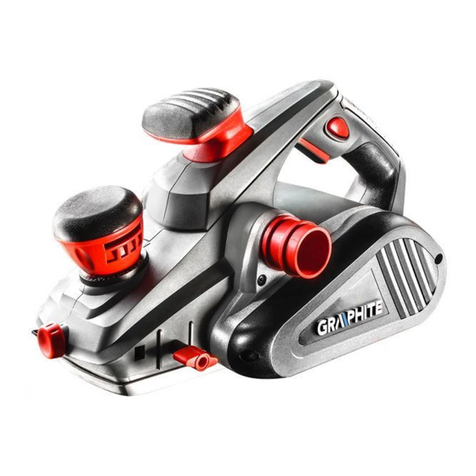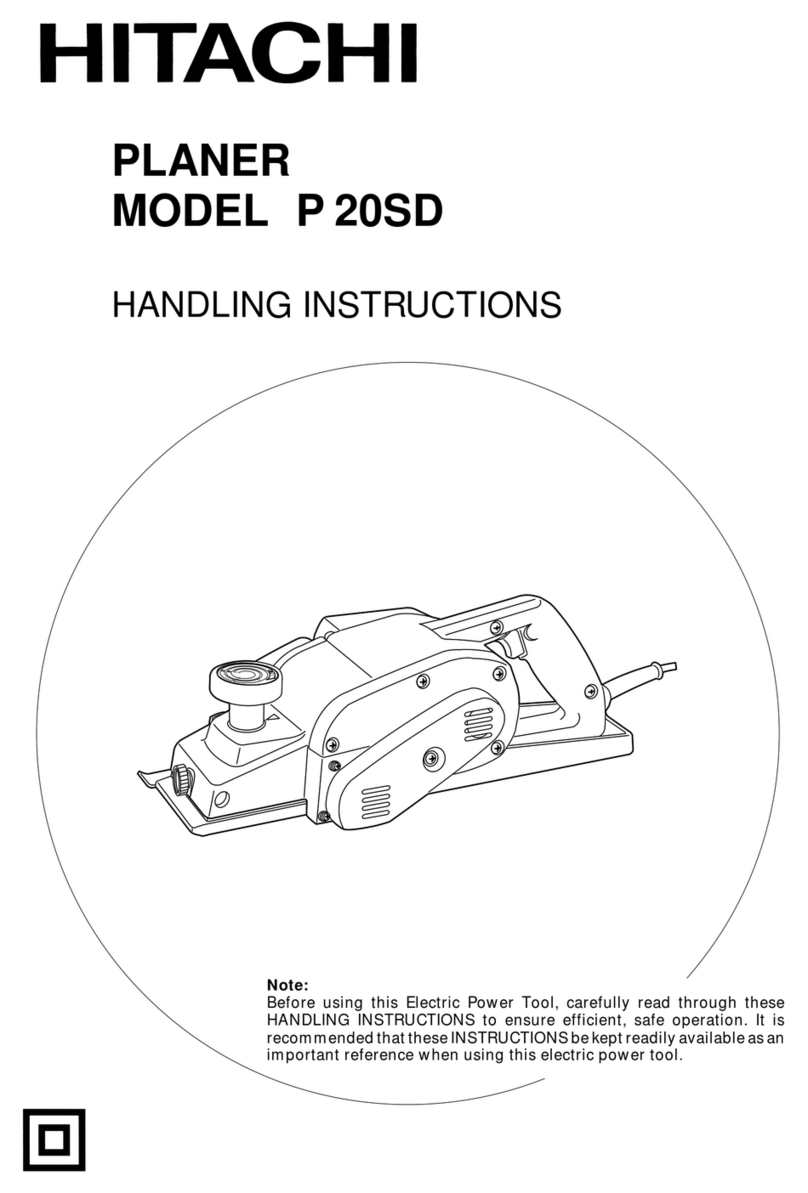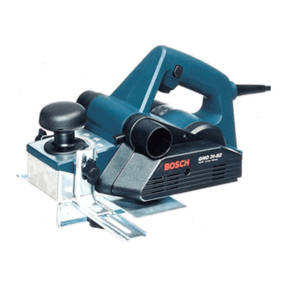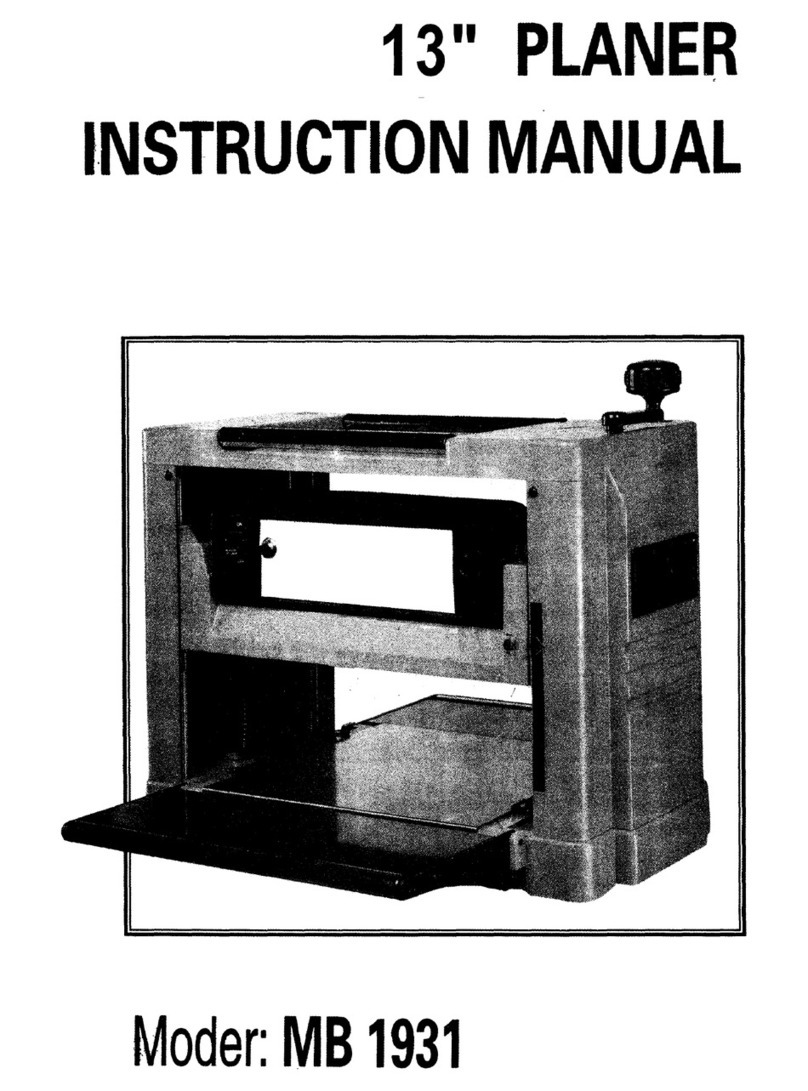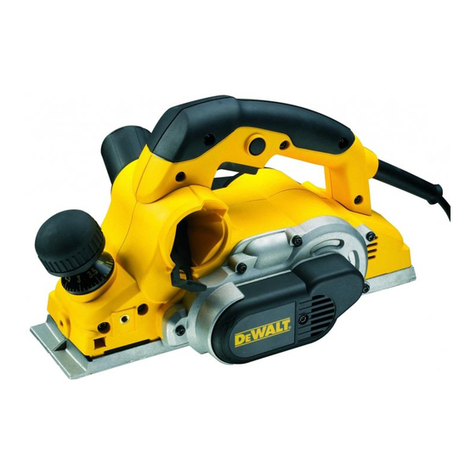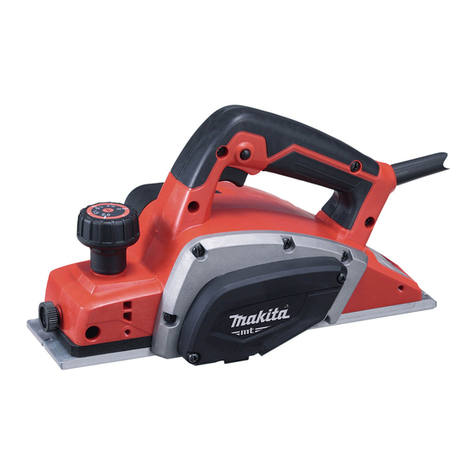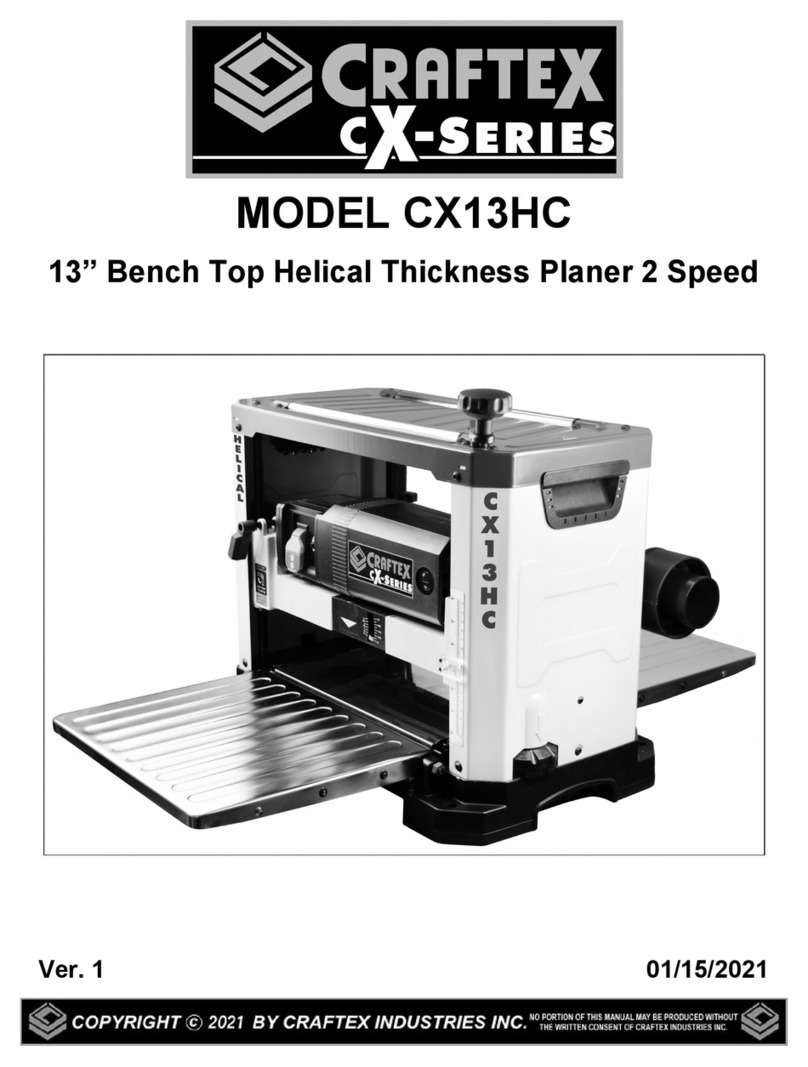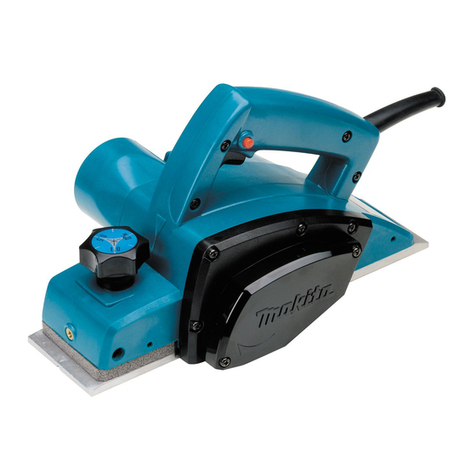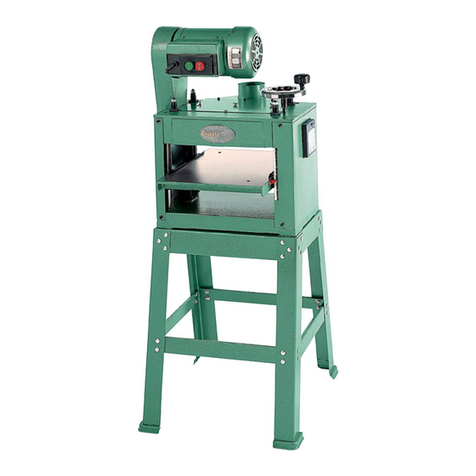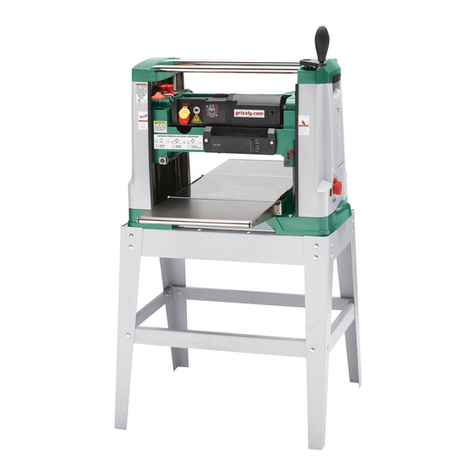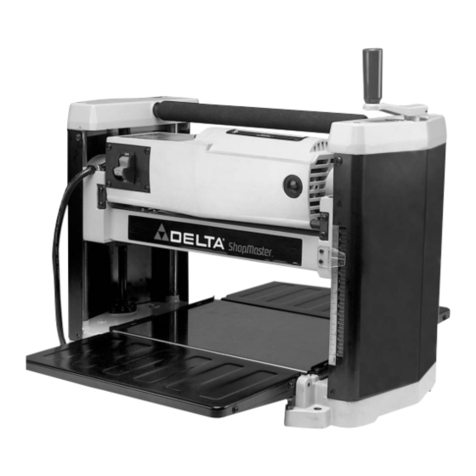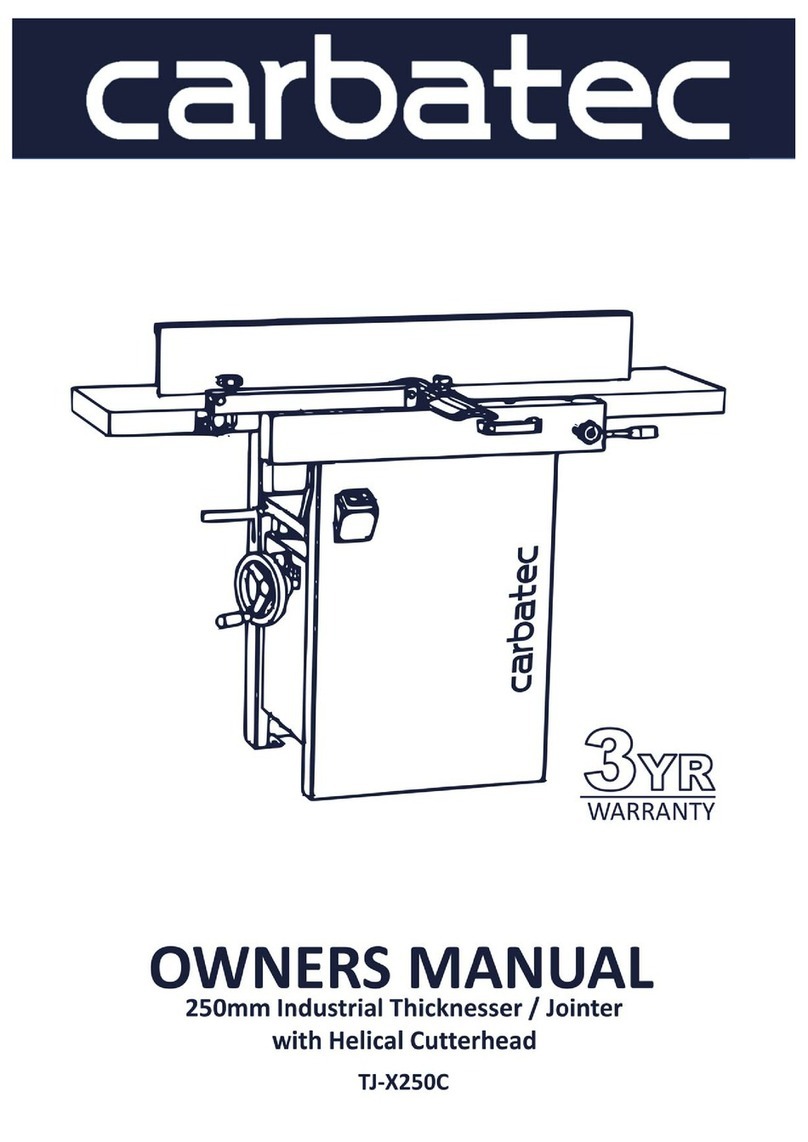Graphite 59G678 User manual

59G678
STRUG ELEKTRYCZNY
ELECTRIC PLANER
ELEKTROHOBEL
ЭЛЕКТРИЧЕСКИЙ РУБАНОК
ГЕМБЕЛЬ ЕЛЕКТРИЧНИЙ
ELEKTROMOS KÉZIGYALU
RINDEA ELECTRICA
ELEKTRICKÝ HOBLÍK
ELEKTRICKÝ HOBLÍK
ELEKTRIČNI OBLIČ
ELEKTRINIS OBLIUS
ELEKTRISKĀ ĒVELE
ELEKTRILINE HÖÖVEL
ЕЛЕКТРИЧЕСКО РЕНДЕ
ELEKTRIČNA BLANJALICA
ELEKTRIČNA BLANJA
ΗΛΕΚΤΡΙΚΗ ΠΛΑΝΗ
PIALLETTO ELETTRICO
ES CEPILLO ELÉCTRICO
G.0614

2

3
INSTRUKCJA OBSŁUGI..................... 6
INSTRUCTION MANUAL ................... 12
BETRIEBSANLEITUNG ..................... 17
РУКОВОДСТВО ПО ЭКСПЛУАТАЦИИ ...... 22
ІНСТРУКЦІЯ З ЕКСПЛУАТАЦІЇ. . . . . . . . . . . . . . 27
HASZNÁLATI UTASÍTÁS.................... 32
INSTRUCTIUNI DE DESERVIRE ............. 37
INSTRUKCE K OBSLUZE.................... 42
NÁVOD NA OBSLUHU ..................... 47
NAVODILA ZA UPORABO .................. 52
APTARNAVIMO INSTRUKCIJA .............. 57
LIETOŠANAS INSTRUKCIJA ................ 62
KASUTUSJUHEND......................... 67
ИНСТРУКЦИЯ ЗА ОБСЛУЖВАНЕ .......... 72
UPUTE ZA UPOTREBU ..................... 77
UPUTSTVO ZA UPOTREBU................. 82
ΟΔΗΓΙΕΣ ΧΡΗΣΗΣ......................... 87
MANUALE PER L’USO...................... 92
MANUAL DE USUARIO..................... 97
ES

4
23
4
1
20
8
11
9
10
14
7
6
12
13
5
19

5
A
5
19
B
20
5
19
C
5
19
D
10
98
11
E
13
12
F
7
6
1
3
2
G
press
H
max
3mm
I
6
18
JK
21
17
16
15
L
22

6
INSTRUKCJA ORYGINALNA (OBSŁUGI)
STRUG ELEKTRYCZNY
59G678
UWAGA: PRZED PRZYSTĄPIENIEM DO UŻYTKOWANIA ELEKTRONARZĘDZIA NALEŻY UWAŻNIE PRZECZYTAĆ
NINIEJSZĄ INSTRUKCJĘ I ZACHOWAĆ JĄ DO DALSZEGO WYKORZYSTANIA.
SZCZEGÓŁOWE PRZEPISY BEZPIECZEŃSTWA
SZCZEGÓLNE WARUNKI BEZPIECZEŃSTWA DLA STRUGA ELEKTRYCZNEGO
Przed podłączeniem struga do gniazdka zasilania zawsze należy upewnić się czy napięcie sieci jest●
zgodne z napięciem podanym na tabliczce znamionowej urządzenia.
Strug wolno podłączać tylko do instalacji elektrycznej wyposażonej w zabezpieczenie różnicowo●
prądowe, które przerwie zasilanie, jeżeli prąd upływu przekroczy 30mA w czasie krótszym niż 30ms.
Należy stosować wyłącznie naostrzone elementy tnące.●
Przed odłożeniem struga po zakończeniu pracy należy odczekać do całkowitego zatrzymania się jego●
elementów wirujących.
W czasie pracy strugiem należy stosować ochronniki słuchu.●
W czasie użytkowania struga należy pewnie trzymać go obiema rękami.●
Przewód zasilający struga zawsze powinien znajdować się po stronie bezpiecznej nie narażony na●
przypadkowe uszkodzenie przez działające elektronarzędzie.
Przed przystąpieniem do pracy strugiem należy upewnić się czy w obrabianym materiale nie ma●
obiektów metalowych takich jak gwoździe czy śruby.
Nie wolno umieszczać palców w otworze króćca wyrzucania pyłu. Króciec należy czyścić za pomocą●
kawałka drewna.
Materiał obrabiany należy zamocować, aby nie dopuścić do jego przesunięcia.●
UWAGA! Urządzenie służy do pracy wewnątrz pomieszczeń.
Mimo zastosowaniakonstrukcji bezpiecznej z samego założenia, stosowaniaśrodków zabezpieczających i
dodatkowych środków ochronnych, zawsze istnieje ryzyko szczątkowe doznaniaurazów podczas pracy.
BUDOWA I PRZEZNACZENIE
Strug jest ręcznym elektronarzędziem z izolacją II klasy. Urządzenie jest napędzane jednofazowym silnikiem
komutatorowym. Strug przeznaczony jest do skrawania powierzchni wyrobów drewnianych.
Obszary jego użytkowania to wykonawstwo prac remontowo - budowlanych, stolarskich oraz wszelkich
prac z zakresu samodzielnej działalności amatorskiej (majsterkowanie).
Nie wolno używać elektronarzędzianiezgodnie z jego przeznaczeniem.
OPIS STRON GRAFICZNYCH
Poniższa numeracja odnosi się do elementów urządzenia przedstawionych na stronach gracznych
niniejszej instrukcji.
Pokrętło regulacji głębokości skrawania1.
Włącznik2.
Przycisk blokady włącznika3.
Osłona paska napędowego4.
Króciec odprowadzania pyłu5.
Stopa przednia6.
Podziałka głębokości skrawania7.
Pokrętło blokady ustawienia prowadnicy równoległej8.
Prowadnica równoległa9.
Wspornik10.
Pokrętło blokady wspornika11.
Prowadnica do strugania wgłębnego12.
Pokrętło blokady prowadnicy do strugania wgłębnego13.

7
Uchwyt prowadzący14.
Śruby mocujące15.
Nóż16.
Głowica17.
Rowek V18.
Adapter19.
Przycisk blokady adaptera20.
Osłona uchylna21.
Stopka parkująca22.
* Mogą występować różnice między rysunkiem a wyrobem.
OPIS UŻYTYCH ZNAKÓW GRAFICZNYCH
UWAGA
OSTRZEŻENIE
MONTAŻ/USTAWIENIA
INFORMACJA
WYPOSAŻENIE I AKCESORIA
Worek na pył - 1 szt1.
Klucz płaski - 1 szt2.
Prowadnica równoległa + wspornik - 1 kpl3.
Prowadnica do strugania wgłębnego - 1 szt4.
Adapter (zamontowany do struga) - 1 szt5.
Śruba + pokrętła - 1 kpl6.
PRZYGOTOWANIE DO PRACY
ODPROWADZANIE PYŁU
Strug posiadasystemodprowadzaniapyłu, który zapobieganadmiernemu nagromadzeniu się pyłu
w miejscu pracy. W przypadku długiej pracy strugiemprzy materiałach, których obróbce towarzyszy
powstawanie pyłu szkodliwego dlazdrowiastrug powinien być podłączony do zewnętrznego
urządzeniaodsysaniapyłu.
MONTAŻ / DEMONTAŻ ADAPTERA
Adapter może być montowany po prawej lub lewej stronie struga w zależności od potrzeb (rys. A).
●Wcisnąć przycisk blokady adaptera (20) i wysunąć adapter (19) z króćca odprowadzania pyłu (5) (rys. B).
Wsunąć adapter (●19) (zwracając uwagę, aby jego występ trał w prowadzenie) do króćca odprowadzania
pyłu (5) do słyszalnego zaskoczenia przycisku blokady adaptera (20).
MONTAŻ WORKA NA PYŁ
Celem utrzymania czystości powierzchni obrabianej strug ma dołączony worek do gromadzenia pyłu.
●Wsunąć otwór worka na pył na adapter (19) (rys. C)
Sprawdzić pewność osadzenia worka na pył przez lekkie pociągnięcie za worek.●
Demontaż worka na pył przebiega w odwrotnej kolejności do jego montażu.
●
Regularnie należy opróżniać worek na pył, co zapewnia wydajne działanie struga. Zaleca się opróżniać
worek na pył już po napełnieniu go w połowie.
MONTAŻ PROWADNICY RÓWNOLEGŁEJ
●Umieścić wspornik (10) w prowadzeniu (po lewej stronie) obudowy struga i zamocować pokrętłem
blokady wspornika (11) (w wyposażeniu).

8
Zamocować prowadnicę równoległą (●9) do wspornika (10) wykorzystując dostarczoną śrubę i pokrętło
(8) (rys. D).
Ustawić prowadnicę równoległą na odpowiednią szerokość skrawania.●
Listwaprowadzącaprowadnicy równoległej powinnabyć skierowanado dołu.
MONTAŻ PROWADNICY DO STRUGANIA WGŁĘBNEGO
●Umieścić prowadnicę do strugania wgłębnego (12) w prowadzeniu (po prawej stronie) obudowy struga
i zamocować pokrętłem blokady prowadnicy (13) (w wyposażeniu) (rys. E).
Ustawić głębokość skrawania korzystając z podziałki umieszczonej na prowadnicy do strugania●
wgłębnego (12).
REGULACJA GŁĘBOKOŚCI SKRAWANIA
Stopa przednia (6) jest ruchoma, co pozwala na regulację głębokości skrawania.
Głębokość skrawania reguluje się pokrętłem regulacji głębokości skrawania (1) w zakresie od 0 – 3 mm
według podziałki głębokości skrawania (7) umieszczonej na jego obwodzie (rys. F).
PRACA / USTAWIENIA
WŁĄCZANIE / WYŁĄCZANIE
Napięcie sieci musi odpowiadać wielkości napięciapodanego natabliczce znamionowej struga.
Podczas uruchamianiai pracy strug należy trzymać obiema rękami.
Strug posiada włącznik zabezpieczający przed przypadkowym uruchomieniem.
Włączanie:
Wcisnąć przycisk blokady włącznika (●3) (rys. G).
Wcisnąć przycisk włącznika (●2).
Wyłączanie:
Zwolnić nacisk na przycisk włącznika (●2).
Przed włączeniemstruganależy uchwycić go pewnie obiema rękami. Strug możnawłączać tylko
wtedy, gdy stopaprzedniajest opartanamateriale przewidzianymdo obróbki, anoże struganie
dotykają materiału. Takie umieszczenie zapobiegaprzedwczesnemu zetknięciu noży z materiałem.
Pracę możnarozpocząć dopiero wtedy, gdy strug osiągnie maksymalną prędkość obrotową.
W czasie posługiwania się strugiem należy dążyć do równoległego usytuowania powierzchni stopy struga
i powierzchni materiału obrabianego. Strug należy prowadzić obiema rękami przy równomiernym ciągłym
posuwie po powierzchni materiału. Rezultaty pracy zależą od prędkości przesuwu struga i głębokości
skrawania. Prace zgrubne wykonuje się stosując większą głębokość skrawania. Przy wygładzaniu
powierzchni zaleca się ustawiać niewielkie głębokości obróbki i pracę wykonywać kilkoma operacjami.
Nie wolno dociskać strugazbyt silnie. Nacisk powinien być umiarkowany i rozłożony równomiernie
napowierzchnię styku stopy z materiałemobrabianym. Wywieranie zbyt dużego nacisku nastrug
spowoduje nienormalny spadek prędkości obrotowej, nadmierne nagrzewanie silnika, uszkodzenie
materiału obrabianego i elementów struga. Stosować okresowe przerwy w pracy.
STRUGANIE WGŁĘBNE
Dzięki możliwości użycia prowadnicy do strugania wgłębnego i prowadnicy równoległej można wykonywać
zagłębienia w materiale.
Zamocować prowadnicę równoległą (●9) i prowadnicę do strugania wgłębnego (12).
Ustawić szerokość i głębokość skrawania.●
Wykonać obróbkę materiału (●rys. H).
OBRÓBKA NAROŻY FAZOWANIE
Umieszczone rowki V (18) na stopie przedniej (6) (rys. I) umożliwiają szybką obróbkę (fazowanie), krawędzi
obrabianego materiału. Umieścić jeden z rowków V na krawędzi materiału obrabianego i prowadzić strug
do przodu zwracając uwagę na ustawienie kąta 450 (rys. J).

9
STOPKA PARKUJĄCA
Stopka parkująca (22)umożliwia bezpieczne odłożenie struga podczas pracy, bez ryzyka uszkodzenia
powierzchni przedmiotu obrabianego lub noży struga. Podczas obróbki stopka parkująca (22)unosi się do
góry i zwalnia tylną stopę struga (rys. L).
OBSŁUGA I KONSERWACJA
Przed przystąpieniemdo jakichkolwiek czynności związanych z instalowaniem, regulacją, naprawą
lub obsługą należy wyjąć wtyczkę przewodu zasilającego z gniazdkasieciowego.
●Strug najlepiej czyścić za pomocą miękkiej szczotki lub strumienia sprężonego powietrza.
Do czyszczenia struga nie wolno używać jakichkolwiek przedmiotów ściernych.●
Do czyszczenia nie wolno stosować wody lub chemicznych środków czyszczących.●
Czyścić strug regularnie, a najlepiej po zakończeniu każdej pracy.●
Strug i jego szczeliny wentylacyjne należy zawsze utrzymywać w czystości.●
Strug zawsze należy przechowywać w miejscu suchym, niedostępnym dla dzieci.●
W przypadku występowania nadmiernego iskrzenia na komutatorze zlecić sprawdzenie stanu szczotek●
węglowych silnika osobie wykwalikowanej.
Po zakończeniu pracy należy opróżnić worek na pył, umyć w ciepłej wodzie z mydłem i starannie●
wysuszyć.
WYMIANA NOŻY STRUGA
Należy stosować wyłącznie głowice tnące zalecane przez producenta, które obejmują noże,
bęben, elementy mocowanianoży, odpowiednie śruby i wrzeciono. Zawsze dokonuje się wymiany
jednocześnie obu noży.
Nowe noże muszą być takiej samej wielkości i mieć taką samą masę jak noże stare. W przeciwnym
wypadku głowicamoże zacząć drgać, obróbkabędzie przebiegać niewłaściwie i może dojść do
uszkodzenianoży lub głowicy struga. Zbyt duży posuw znacznie redukuje wydajność i jakość pracy
oraz trwałość noży. Należy używać tylko ostrych noży. Chronić strug przed stępieniemnoży. Noże
należy wymieniać jak tylko zaistnieje takapotrzeba.
●Poluzować śruby mocujące (15) nóż (16) za pomocą klucza ( w wyposażeniu) (rys. K).
Obrócić głowicę (●17) o pół obrotu i powtórzyć ten zabieg dla drugiego noża.
Wcisnąć osłonę uchylną (●21) i wysunąć noże.
Wymienić noże na nowe i zamontować w kolejności odwrotnej do ich demontażu.●
Upewnić się czy noże są umieszczone symetrycznie w prowadnicy głowicy (●17).
Dokręcić śruby mocujące (●15) równomiernie i na przemian.
Po zamontowaniu noży w głowicy należy pamiętać, aby wkręty i śruby były pewnie dokręcone. Ich
nie dokręcenie może być powodemuszkodzeniastrugalub ciałaużytkownika. Ostrzanoży muszą
być równoległe do powierzchni walcagłowicy. W przeciwnymrazie obrabianapowierzchnianie
będzie płaskai równa. Należy stosować wyłącznie głowicę, którajest dostarczanałącznie z wyrobem
lub dostarczoną przez wytwórcę albo jego autoryzowanego dystrybutora.
WYMIANA PASKA NAPĘDOWEGO
Jeśli pasek napędowy jest zużyty to strug nie pracuje właściwie. Konieczna jest wymiana paska
napędowego.
Odkręcić wkręty mocujące i zdjąć osłonę paska napędowego (●4).
Zdjąć pasek napędowy zsuwając go z kół poprzez obracanie kół ręką.●
Montaż nowego paska napędowego należy przeprowadzić w następujący sposób:●
założyć pasek napędowy na mniejsze koło.–
obracając kołami nasunąć pasek napędowy na większe koło.–
Upewnić się czy pasek jest dobrze ułożony na obu kołach.●
Zamontować osłonę paska napędowego (●4) dokręcając wkręty mocujące.

10
WYMIANA SZCZOTEK WĘGLOWYCH
Zużyte (krótsze niż 5 mm), spalone lub pęknięte szczotki węglowe silnikanależy natychmiast
wymienić. Zawsze dokonuje się jednocześnie wymiany obu szczotek węglowych.
Czynność wymiany szczotek węglowych należy powierzyć wyłącznie osobie wykwalikowanej
wykorzystując części oryginalne.
Wszelkiego rodzaju usterki powinny być usuwane przez autoryzowany serwis producenta.
PARAMETRY TECHNICZNE
DANE ZNAMIONOWE
Strug elektryczny
Parametr Wartość
Napięcie zasilania 230 V AC
Częstotliwość zasilania 50 Hz
Moc znamionowa 850 W
Prędkość obrotowa na biegu jałowym 16500 min-1
Klasa ochronności II
Ilość noży 2
Szerokość planowania 82 mm
Głębokość obróbki przy planowaniu 0 - 3 mm
Max.głębokość obróbki przy struganiu
wgłębnym 0 - 12 mm
Masa 3,1 kg
Rok produkcji 2014
DANE DOTYCZĄCE HAŁASU I DRGAŃ
Poziom ciśnienia akustycznego: LpA= 93,7 dB(A) K = 3 dB(A)
Poziom mocy akustycznej: LwA= 104,7 dB(A) K = 3 dB(A)
Wartość przyspieszeń drgań: ah= 3,987 m/s2K = 1,5 m/s2
OCHRONA ŚRODOWISKA / CE
Produktów zasilanych elektrycznie nie należy wyrzucać wraz z domowymi odpadkami, lecz oddać je
do utylizacji w odpowiednich zakładach. Informacji na temat utylizacji udzieli sprzedawca produktu
lub miejscowe władze. Zużyty sprzęt elektryczny i elektroniczny zawiera substancje nieobojętne
dla środowiska naturalnego. Sprzęt nie poddany recyclingowi stanowi potencjalne zagrożenie dla
środowiska i zdrowia ludzi.
* Zastrzega się prawo dokonywania zmian.
„Grupa Topex Spółka z ograniczoną odpowiedzialnością” Spółka komandytowa z siedzibą w Warszawie, ul. Pograniczna
2/4 (dalej: „Grupa Topex”) informuje, iż wszelkie prawa autorskie do treści niniejszej instrukcji (dalej: „Instrukcja”), w tym
m.in. jej tekstu, zamieszczonych fotograi, schematów, rysunków, a także jej kompozycji, należą wyłącznie do Grupa Topex
i podlegają ochronie prawnej zgodnie z ustawą z dnia 4 lutego 1994 roku, o prawie autorskim i prawach pokrewnych (tj.
Dz. U. 2006 Nr 90 Poz 631 z późn. zm.). Kopiowanie, przetwarzanie, publikowanie, modykowanie w celach komercyjnych
całości Instrukcji jak i poszczególnych jej elementów, bez zgody GrupaTopex wyrażonej na piśmie, jest surowo zabronione
i może spowodować pociągnięcie do odpowiedzialności cywilnej i karnej.

11
DeklaracjaZgodności WE
/EC Declaration of Conformity/
/Megfelelési Nyilatkozat (EK)/
Producent / Manufacturer / Gyártó / Grupa Topex Sp. z o.o. Sp. k.
Ul. Pograniczna 2/4, 02-285 Warszawa, Polska
Wyrób / Product / Termék / Strug elektryczny / Electric Planer / Elektromos Kézigyalu
Model / Model. / Modell / 59G678
Numer seryjny / Serial number / Sorszám / 00000 ÷ 99999
Opisany wyżej wyrób jest zgodny z następującymi dokumentami:
/The above listed product is in conformity with the following UE Directives:/
/A fent jelzett termék megfelel az alábbi irányelveknek:/
Dyrektywa Maszynowa 2006/42/WE
/Machinery Directive 2006/42/EC/
/ 2006/42/EK Gépek /
Dyrektywa o Kompatybilności Elektromagnetycznej 2004/108/WE
/EMC Directive 2004/108/EC /
/2004/108/EK Elektromágneses összeférhetőség/
Dyrektywa o RoHS 2011/65/UE
/RoHS Directive 2011/65/UE/
2011/65/EK RoHS
oraz spełnia wymagania norm:
/and fulls requirements of the following Standards:/
/valamint megfelel az alábbi szabványoknak:/
EN 60745-1/A11:2010 ; EN 60745-2-14/A2:2010 ; EN 55014-1/A2:2011 ; EN 55014-2/A2:2008
EN 61000-3-2/A2:2009 ; EN 61000-3-3:2008 ; EN 62321:2009
Jednostka notykowana
/Noied body/
/Bejelentett szervezet/
TŰV SŰD Product Service GmbH, Ridlerstraβe 65, 80339 Műnchen, Germany NB. 0123
Ostatnie dwie cyfry roku, w którym umieszczono znak CE: 10
/Last two gures of CE marking year:/
/A CE jelzés felhelyezése évének utolsó két számjegye:/
Nazwisko i adres osoby mającej miejsce zamieszkania lub siedzibę w UE upoważnionej do przygotowania dokumentacji
technicznej
/Name and address of the person who established in the Community and authorized to compile the technical le/
/A műszaki dokumentáció összeállítására felhatalmazott, a közösség területén lakóhellyel vagy székhellyel rendelkező személy
neve és címe./
Paweł Szopa
Ul. Pograniczna 2/4
02-285 Warszawa
........................................................
Paweł Szopa
Pełnomocnik ds. jakości rmy GRUPA TOPEX
/GRUPA TOPEX Quality Agent /
/A GRUPA TOPEX Minőségügyi meghatalmazott képviselője/
Warszawa, 2014-05-22

12
TRANSLATION OFTHE ORIGINAL INSTRUCTIONS
ELECTRIC PLANER
59G678
CAUTION: BEFORE USING THE POWER TOOL READ THIS MANUAL CAREFULLY AND KEEP IT FOR FUTURE
REFERENCE.
DETAILED SAFETY REGULATIONS
SPECIAL CONDITIONS REGARDING SAFETY OF ELECTRIC PLANER OPERATION
Before connecting the planer to mains socket make sure the supply voltage matches the voltage on the●
rating plate of the tool.
Connect the planer only to electrical system equipped with residual current circuit breaker that will cut●
the power o when earth leakage current exceeds 30 mA in less than 30 ms.
Use only sharp cutting parts.●
After the work has been nished and before putting the planer away wait until rotating parts stop●
completely.
Use hearing protection measures when working with planer.●
When using the planer hold it rmly with both hands.●
Power cord of the planer must be on the safe side, where there is no danger of accidental damage by●
operating power tool.
Before starting operation ensure there are no metal objects, such as nails or screws, in the processed●
material.
Do not put ngers into dust outlet hole. Clean the outlet with a piece of wood.●
Fix processed material to prevent it from slipping.●
CAUTION!This device is designed to operate indoors.
The design is assumed to be safe, protection measures and additional safety systems are used,
nevertheless there is always asmall risk of operational injuries.
CONSTRUCTION AND USE
Planer is a hand-held power tool with insulation class II. The tool is driven by single-phase commutator
motor. Planer is designed for processing wooden surfaces.
Range of use covers repair and building works, woodworking and any work from the scope of individual,
amateur activities (tinkering).
Use the power tool according to the manufacturer’s instructions only.
DESCRIPTION OF DRAWING PAGES
Below enumeration refers to the device elements depicted on the drawing pages of this manual.
Knob for planing depth adjustment1.
Switch2.
Switch lock button3.
Drive belt cover4.
Dust extraction outlet5.
Front footplate6.
Planing depth scale7.
Parallel guide position locking wheel8.
Parallel guide9.
Support
10.
Support locking knob11.
Deep planing guide12.
Locking knob for deep planing guide13.
Guide handle14.
Fixing screws15.

13
Blade16.
Head17.
V groove18.
Adaptor19.
Adaptor lock button20.
Removable shield21.
Park rest22.
* Dierences may appear between the product and drawing.
MEANING OF SYMBOLS
CAUTION
WARNING
ASSEMBLY/SETTINGS
INFORMATION
EQUIPMENT AND ACCESSORIES
Dust bag - 1 pce1.
Flat spanner - 1 pce2.
Parallel guide + support - 1 set3.
Deep planing guide - 1 pce4.
Adaptor (attached to planer) - 1 pce5.
Screw + knobs - 1 set6.
PREPARATION FOR OPERATION
DUST EXTRACTION
Planer is equipped with dust extraction system, which prevents excessive deposition of dust in the
work place. When operating the planer for along time on the surfaces that produce harmful dust,
the planer must be connected to external dust suction device.
INSTALLATION / DEINSTALLATION OF ADAPTOR
Depending on the needs, adaptor can be attached on left or right side of the planer (g. A).
●Press the adaptor lock button (20) and pull the adaptor (19) out of the dust extraction outlet (5) (g. B).
Slide the adaptor (●19) into the dust extraction outlet (5) (be careful to place protrusion in the notch),
make sure you can hear the adaptor lock button (20) snaps.
DUST BAG INSTALLATION
Equipment of the planer includes dust bag to maintain the processed surface clean.
●Place the dust bag hole on the adaptor (19) (g. C).
Pull the dust bag gently to check if it is well xed.●
Deinstallation of the dust bag is similar to installation, only the sequence of actions is reversed.●
Empty the dust bag on a regular basis, this will ensure ecient operation of the planer. Emptying the bag
when it is half-full is recommended.
PARALLEL GUIDE INSTALLATION
●Place the support (10) in the guide (on the left side) in the planer body and secure with support locking
knob (11) (included).
Use the supplied screw and locking wheel (●8) to attach parallel guide (9) to the support (10) (g. D).
Set parallel guide to appropriate planing width.●
Parallel guide bar should be pointed downwards.

14
INSTALLATION OF DEEP PLANING GUIDE
●Place the deep planing guide (12) in the guide (on the right side) in the planer body and secure with the
locking knob for deep planing guide (13) (included) (g. E).
Use the scale on the deep planing guide (●12) to set planing depth.
PLANING DEPTH ADJUSTMENT
Planer front footplate (6) is movable and it allows for planing depth adjustment.
Planing depth can be adjusted with the knob for planing depth adjustment (1) and the range is 0 – 3 mm,
shown on the planing depth scale (7) located on its circumference (g. F).
OPERATION / SETTINGS
SWITCHING ON / SWITCHING OFF
The mains voltage must match the voltage on the rating plate of the planer. Hold the planer with
both hands when starting up and during operation.
The planer features switch that protects against unintentional starting up.
Switching on:
Press the switch lock button (●3) (g. G).
Press the switch button (●2).
Switching o:
Release pressure on the switch button (●2).
Hold the planer rmly with both hands before switching it on. Switch on the planer only when the
front footplate rests on the material that you plan to process and the planer blades do not touch
material. This position prevents too early contact of blades with material. Start the work only after
the planer reaches its top rotational speed.
When using the planer, try to position planer footplate and surface of processed material in parallel. Guide the
planer with both hands, move it smoothly and continuously on the material surface. Eects of work depend
on speed of planer movement and depth of planing. Coarse processing uses bigger planing depth. During
ne processing it is recommended to set small planing depth and to proceed with work in few runs.
Do not press the planer too hard. Pressure should be moderate and uniformon the whole surface
of contact of foot and processed material. Applying too big pressure causes undesirable drop of
rotational speed, motor overheating, damage of processed material and parts of the planer. Make
periodic breaks in operation.
DEEP PLANING
You can use the deep planing guide and the parallel guide to make hollows in material.
Attach the parallel guide (●9) and the deep planing guide (12).
Set planing width and depth.●
Process the material (●g. H).
PROCESSING CORNERS CHAMFERING
V-grooves (18) located on the front footplate (6) (g. I) allow for quick processing (chamfering) of edges
of processed material. Place one of the V-grooves on the edge of processed material and move the planer
forward, make sure to keep the 450angle (g. J).
PARK REST
Park rest (22) allows to put away the planer safely during operation without the risk of damaging processed
surface or the planer blades. The park rest (22) lifts up when processing and releases the back footplate of
the planer (g. L).

15
OPERATION AND MAINTENANCE
Unplug the power cord frommains socket before commencing any activities related to installation,
adjustment, repair or maintenance.
●Soft brush or compressed air are best for cleaning the planer.
Do not use abrasive objects for cleaning the planer.●
Do not clean with water or chemical cleaning agents.●
Clean the planer regularly, optimally after each use.●
Always keep the planer and ventilation holes clean.●
Store the planer in dry place, beyond reach of children.●
In case of excessive commutator sparking, have the technical condition of carbon brushes of the motor●
checked by a qualied person.
When the work is nished empty the dust bag, next wash it in warm water with soap and dry it●
thoroughly.
REPLACEMENT OF PLANER BLADES
Use only cutting heads that are recommended by the manufacturer, and that include blades, drum,
blade xing parts, appropriate bolts and spindle. Always replace both blades at atime.
New blades must be of the same size and weight as old ones. Otherwise the head may vibrate,
processingmay be improperanditmaydamagebladesorplanerhead.Too fast advanceconsiderably
reduces eciency and quality of work and durability of blades. Use only sharp blades. Avoid blunting
the blades. Replace blades as soon as it is necessary.
●Use the spanner (included) to loosen xing screws (15) of the blade (16) (g. K).
Turn the head (●17) by 1800and repeat this operation for the second blade.
Press in the removable shield (●21) and slide the blades out.
Replace the blades with new ones and proceed with installation in reverse sequence of disassembly.●
Make sure the blades are positioned symmetrically in the guide of the head (●17).
Tighten screws (●15) that x blades alternately and with the same force.
Ensure screws and bolts are tightened after blades are installed in the head. Failing to do so may
cause damage of the planer or the user’s body injury. Blade edges must be parallel to the head drum
surface. Otherwise the processed surface will not be at and even. Use only head that is supplied
with the product, head supplied by the manufacturer or its authorized distributor.
REPLACEMENT OF DRIVE BELT
Planer does not work properly if drive belt is worn. Belt replacement is necessary.
Unscrew xing screws and remove the drive belt cover (●4).
Remove the drive belt by turning the pulleys manually and pulling the belt o.●
To install new drive belt do as follows:●
put the drive belt onto smaller pulley,-
rotate pulleys and draw the drive belt over the bigger pulley.-
Ensure the belt is correctly set on both pulleys.●
Install drive belt cover (●4) and tighten xing screws.
REPLACEMENT OF CARBON BRUSHES
Replace immediately worn out (shorter than 5 mm), burnt or cracked motor carbon brushes. Always
replace both carbon brushes at atime.
Entrust replacement of carbon brushes only to aqualied person. Only original parts should be
used.
All faults should be repaired by service workshop authorized by the manufacturer.

16
TECHNICAL PARAMETERS
RATED PARAMETERS
Electric Planer
Parameter Value
Supply voltage 230 V AC
Input current frequency 50 Hz
Rated power 850 W
Idle rotational speed 16500 rmp
Protection class II
Number of blades 2
Planing width 82 mm
Processing depth for planing 0 - 3 mm
Max. processing depth for deep planing 0 - 12 mm
Weight 3,1 kg
Year of production 2014
NOISE LEVEL AND VIBRATION PARAMETERS
Sound pressure: LpA= 93,7 dB(A) K = 3 dB(A)
Sound power: LwA= 104,7 dB(A) K = 3 dB(A)
Vibration acceleration: ah = 3,987 m/s2. K = 1,5 m/s2
ENVIRONMENT PROTECTION
Do not dispose of electrically powered products with household wastes, they should be utilized in
proper plants. Obtain information on wastes utilization from your seller or local authorities. Used up
electric and electronic equipment contains substances active in natural environment. Unrecycled
equipment constitutes a potential risk for environment and human health.
* Right to introduce changes is reserved.
“Grupa Topex Spółka z ograniczoną odpowiedzialnością” Spółka komandytowa with seat in Warsaw at ul. Pograniczna
2/4 (hereinafter Grupa Topex) informs, that all copyrights to this instruction (hereinafter Instruction), including, but not
limited to, text, photographies, schemes, drawings and layout of the instruction, belong to Grupa Topex exclusively and are
protected by laws accordingly to Copyright and Related Rights Act of 4 February 2004 (ustawa o prawie autorskim i prawach
pokrewnych, Dz. U. 2006 No 90 item 631 with later ammendments). Copying, processing, publishing, modications for
commercial purposes of the entire Instruction or its parts without written permission of Grupa Topex are strictly forbidden
and may cause civil and legal liability.

17
ÜBERSETZUNG DER ORIGINALBETRIEBSANLEITUNG
ELEKTROHOBEL
59G678
ANMERKUNG: LESEN SIE VOR DER INBETRIEBNAHME DIESES ELEKTROWERKZEUGS GRÜNDLICH DIE
VORLIEGENDE BETRIEBSANLEITUNG DURCH UND BEWAHREN SIE SIE AUF.
DETAILLIERTE SICHERHEITSVORSCHRIFTEN
DETAILLIERTE SICHERHEITSHINWEISE FÜR DEN ELEKTROHOBEL
Vor dem Anschließen des Elektrohobels ans Netz prüfen Sie stets, dass die Netzspannung der auf dem●
Typenschild angegebenen Nennspannung des Gerätes entspricht.
Der Elektrohobel ist nur an die Stromleitung mit dem Dierenzstromschutz anzuschließen, die●
Versorgung unterbrechen wird, falls der Leckstrom 30 mA innerhalb von 30 ms überschreiten wird.
Nur scharfe Schneidelemente verwenden.●
Bevor Sie den Elektrohobel ablegen, warten Sie ab, bis die rotierenden Elemente zum kompletten●
Stillstand kommen.
Beim Gebrauch des Elektrohobels ist der Gehörschutz zu tragen.●
Der Elektrohebel ist beim Betrieb mit beiden Händen festzuhalten.●
Halten Sie stets die Netzanschlussleitung des Elektrohobels auf der sicheren Seite, damit sie mit dem●
Elektrogerät nicht zufällig beschädigt wird.
Vor dem Betrieb stellen Sie sicher, dass sich im Werkstück keine Metallelemente wie Nagel oder●
Schrauben benden.
Halten Sie nie Ihre Finger in der Önung des Staubabsaugstutzens. Reinigen Sie den Stutzen mit einem●
Holzstück.
Befestigen Sie das Werkstück, damit es nicht verschoben wird.●
ACHTUNG! Das Gerät ist für den Betrieb in Innenräumen bestimmt.
Trotz des Einsatzes einer sicheren Konstruktion, von Sicherheitseinrichtungen und zusätzlichen
Schutzeinrichtungen besteht stets das Restrisiko einerVerletzung beimBetrieb des Gerätes.
AUFBAU UND BESTIMMUNG
Der Elektroschleifer ist ein manuell betriebenes Elektrowerkzeug mit der II. Isolierklasse. Das Gerät wird
mit einem einphasigen Kommutatormotor betrieben. Der Elektrohobel ist für die Zerspanung von
Holzerzeugnissen bestimmt.
Der Anwendungsbereich dieses Werkzeugs umfasst die Ausführung von Sanierungs- und Bauarbeiten,
Tischlerarbeiten und aller Arbeiten, die Zuhause selbst durchgeführt werden (Heimwerker).
Nichtbestimmungsgemäße Verwendung des Elektrowerkzeugs ist nicht zugelassen.
BESCHREIBUNG DER SEITEN MIT GRAPHIKEN
Die unten angeführte Nummerierung bezieht sich auf die Elemente des Gerätes, die auf den Seiten mit
Graphiken dargestellt werden.
Einstellring für Zerspanungstiefe1.
Hauptschalter2.
Taste der Schalterverriegelung3.
Abdeckung des Antriebsriemens4.
Staubabsaugstutzen5.
Vorderer Gerätefuß6.
Skala der Bearbeitungstiefe7.
Drehknopf für Einstellsperre der parallelen Führung8.
Parallele Führung9.
Tragarm10.
Drehknopf für Tragarmverriegelung11.
Führung für Tiefhobeln12.

18
Arretierungsring der Führung zum Tiefhobeln13.
Führungsgri14.
Befestigungsschrauben15.
Messer16.
Kopf17.
V-Nut18.
Adapter19.
Taste der Adapterarretierung20.
Schwenkbare Abdeckung21.
Positionierfuß22.
* Es können Unterschiede zwischen der Abbildung und dem Produkt auftreten.
BESCHREIBUNG FÜR VERWENDETE GRAPHISCHE ZEICHEN
ACHTUNG
WARNUNG
MONTAGE/EINSTELLUNGEN
INFORMATION
AUSSTATTUNG UND ZUBEHÖR
Staubbeutel - 1 St.1.
Schraubenschlüssel - 1 St.2.
Parallele Führung + Tragarm - 1 Satz3.
Führung für Tiefhobeln - 1 St.4.
Adapter (am Hobel montiert) - 1 St.5.
Schraube + Drehknöpfe - 1 Satz6.
BETRIEBSVORBEREITUNG
STAUBABFÜHRUNG
Der Elektrohobel verfügt über das Staubsaugsystem, das den Staub vomArbeitsplatz ableitet. Bei
langemGebrauch des Elektrohobels mit Stoen, bei deren Bearbeitung gesundheitsschädliche
Stäube entstehen, ist der Elektrohobel an ein äußeres Staubabsaugsystemanzuschließen.
ADAPTER MONTIEREN / DEMONTIEREN
Der Adapter kann links oder rechts am Elektrohobel (Abb. A) je nach Bedarf montiert werden.
●Die Taste der Adapterarretierung (20) drücken und den Adapter (19) vom Staubabsaugstutzen (5) (Abb.
B) herausziehen.
Den Adapter (●19) in den Staubabsaugstutzen (5) so einschieben (dabei ist darauf zu achten, dass die
Rastnase auf die Nut im Stutzen trit), dass die Taste der Adapterarretierung (20) hörbar einrastet.
STAUBBEUTEL MONTIEREN
Um die zu bearbeitende Oberäche sauber zu halten, ist der Elektrohobel mit einem Staubbeutel
ausgestattet.
●Die Önung des Staubbeutels auf den Adapter (19) aufschieben (Abb. C)
Prüfen Sie durch leichtes Ziehen am Staubbeutel, ob er auf dem Adapter fest sitzt.●
Zum Demontieren des Staubbeutels ist das Montageverfahren umgekehrt anzuwenden.●
Der Staubbeutel ist regelmäßig zu entleeren, um die richtige Funktionsweise des Hobels zu gewährleisten.
Es wird empfohlen, den Staubbeutel nach der Halbfüllung zu entleeren.

19
PARALLELE FÜHRUNG MONTIEREN
●DenTragarm (10) in der Führung (links) am Gehäuse des Elektrohobels einlegen und mit dem Drehknopf
für Tragarmverriegelung (11) (mitgeliefert) montieren.
Die parallele Führung (●9) amTragarm (10) mit der mitgelieferten Schraube und dem Drehknopf (8) (Abb.
D) anbringen.
Die parallele Führung auf entsprechende Bearbeitungstiefe einstellen.●
Die Leiste der parallelen Führung soll naunten zeigen.
FÜHRUNG ZUM TIEFHOBELN MONTIEREN
●Die Führung zum Tiefenhobeln (12) in die Führung (rechts) am Gehäuse des Elektrohobels einlegen und
mit dem Arretierungsring der Führung zum Tiefhobeln (13) (mitgeliefert) (Abb. E) montieren.
Die Zerspanungstiefe mit der Skala an der Führung zum Tiefhobeln (●12) einstellen.
REGULIERUNG DER BEARBEITUNGSTIEFE
Der vordere Gerätefuß (6) ist beweglich, was die Bearbeitungstiefe regulieren lässt.
Die Zerspanungstiefe wird mit dem Einstellring für Zerspanungstiefe (1) im Bereich von 0 bis 3 mm gemäß
der Skala für Zerspanungstiefe (7), die an seinem Umfang untergebracht ist, reguliert (Abb. F).
BETRIEB / EINSTELLUNGEN
EIN/AUSSCHALTEN
Die Netzspannung muss demSpannungswert entsprechen, der imTypenschild des Elektrohobels
angegeben worden ist. BeimStart und Betrieb soll man den Elektrohobel in beiden Händen halten.
Der Elektrohobel verfügt über einen Sicherheitsschalter, der vor einem versehentlichen Start des Werkzeugs
schützt.
Einschalten:
Die Taste der Schalterverriegelung (●3) (Abb. G).
Die Taste des Schalters (●2) drücken.
Ausschalten:
Den Schalter (●2) freigeben.
Vor demEinschalten des Elektrohobels halten Sie sie mit beiden Händen fest. Der Elektrohobel
darf nur dann eingeschaltet werden, wenn er auf demWerkstück gestützt ist und die Messer des
Elektrohobels das Werkstück nicht berühren. Dies wird die vorzeitige Berührung der Messer mit
demWerkstück verhindern. Der Betrieb kann nur dann begonnen werden, wenn der Motor des
Elektrohobels seine maximale Drehzahl erreichen wird.
Beim Gebrauch des Elektrohobels streben Sie nach einer parallelen Lage der Oberäche des Hobels und
des Werkstücks. Führen Sie den Elektrohobel mit beiden Händen und verschieben gleichmäßig an der
Oberäche des Werkstücks. Die Ergebnisse der Arbeit hängen von derVorschubgeschwindigkeit des Hobels
und der Bearbeitungstiefe ab. Die Grobarbeiten werden bei der höheren Bearbeitungstiefe ausgeführt.
Beim Glätten der Oberäche empfehlen wir, geringe Bearbeitungstiefe einzustellen und die Bearbeitung
in mehreren Schritten auszuführen.
Drücken Sie den Elektrohobel nicht zu stark an. Der Andruck soll mittelmäßig und gleichmäßig auf
dieKontaktoberächezwischen demGerätefußundWerkstückverteiltsein.Derallzu starkeAndruck
auf den Hobel wird einen untypischen Rückgang der Geschwindigkeit der Drehzahl, ein zu starkes
Aufheizen des Motors, die Beschädigung des Werkstücks und Maschinenelementen verursachen. Bei
der Arbeit legen Sie ab und zu Pausen ein.
TIEFHOBELN
Mit der Führung zumTiefhobeln und der parallelen Führung können Vertiefungen imWerkstück ausgeführt
werden.
Die parallele Führung (●9) und die Führung zum Tiefhobeln (12) montieren.
Die Zerspanungsbreite und –tiefe sind einzustellen.●
Das Werkstück bearbeiten (●Abb. H).

20
KANTEN BEARBEITEN ABSCHRÄGEN
Mit der Nut V (18) in der Mitte des vorderen Fußes (6) (Abb. I) können die kanten des Werkstücks schnell
bearbeitet (abgeschrägt) werden. Eine der Nuten V auf die Kante des Werkstücks aufsetzen und den Hobel
nach vorne führen, dabei auf den 450 -Winkel achten (Abb. J).
POSITIONIERFUSS
Mit dem Positionierfuß (22)kann der Hobel sicher beim Arbeiten abgelegt werden, ohne, dass die
Oberäche des Werkstücks oder Hobelmesser beschädigt wird. Bei der Bearbeitung geht der Positionierfuß
(22)nach oben und gibt den hinteren Hobelfuß frei (Abb. L).
BEDIENUNG UND WARTUNG
Vor allen Montage-, Einstellungs-, Reparatur- oder Bedienungsarbeiten trennen Sie den Stecker der
Versorgungsleitung aus der Netzsteckdose.
●Der Elektrohebel ist mit einer weichen Bürste oder einem Druckluftstrahl zu reinigen.
Zur Reinigung des Hobels verwenden Sie keine Gegenstände mit Reibeigenschaften.●
Zur Reinigung der Nutfräse dürfen kein Wasser und keine chemischen Reinigungsmittel verwendet●
werden.
Reinigen Sie den Hobel regelmäßig, am besten nach dem Abschluss jeder Arbeit.●
Halten Sie die Lüftungsönungen des Hobels immer sauber.●
Bewahren Sie den Elektrohebel in einem trockenen Ort, weit von der Reichweite von Kindern auf.●
Beim übermäßigen Funken am Kommutator ist eine Fachkraft mit der Prüfung des Zustandes der Motor-●
Kohlebürsten zu beauftragen.
Nach dem Abschluss der Arbeit entleeren Sie den Staubbeutel und waschen Sie ihn im Warmwasser mit●
Seife und anschließend trocknen Sie ihn sorgfältig.
HOBELMESSER AUSTAUSCHEN
Setzen Sie ausschließlich Schneideköpfe, die VomHersteller empfohlen werden. Diese sollen sich
aus Messern,Trommel, Messerhalteelementen, Schrauben und Spindel zusammensetzen. Es werden
immer gleichzeitig beide Messer ausgetauscht.
Neue Messer müssen gleiche Größe und Masse wie die alten Messer haben. Sonst wird es zu
Schwingungen des Schneidekopfes kommen, die Bearbeitung wird nicht richtig ablaufen und die
Messer oder Hobelkopf können beschädigt werden. Der zu hohe Vorschub reduziert erheblich die
Leistung und Qualität der Arbeit sowie die Lebensdauer der Messer. Nur scharfe Messer sind zu
verwenden. Der Hobel ist vor Verstumpfen zu schützen. Tauschen Sie die Messer sofort aus, wenn
es nötig wird.
●Die Befestigungsschrauben (15) für Messer (16) mit dem Schlüssel (im Lieferumfang) lösen (Abb. K).
Den Kopf (●17) um eine halbe Drehung drehen und diese Prozedur für das zweite Messer wiederholen.
Die schwenkbare Abdeckung (●21) drücken und Messer ausfahren.
Messer gegen neue austauschen, zum Montieren ist das Demontageverfahren umgekehrt anzuwenden.●
Stellen Sie sicher, dass die Messer symmetrisch in der Führung des Messerkopfes (●17) sitzen.
Ziehen Sie die Befestigungsschrauben (●15) gleichmäßig und abwechselnd fest.
NachdemAnbringenderMesserimKopfbeachtenSie,dassdieSchraubenfest gezogen werden.Falls
sie nicht fest gezogen werden, kann der Hobel oder Körper des Bedieners beschädigt werden. Die
Messerkante muss parallel an die Oberäche des Wellenkopfes anliegen. Sonst wird die bearbeitete
Oberäche nicht eben und glatt. Verwenden Sie nur einen Kopf, der zusammen mit demProdukt
oder durch den Hersteller bzw. seinen autorisierten Vertreiber geliefert wird.
ANTRIEBSRIEMEN AUSTAUSCHEN
Wenn der Antriebsriemen verschleißt ist, arbeitet die der Hobel nicht richtig. Der Antriebsriemen ist in
einem solchen Fall auszutauschen.
Die Montageschrauben abschrauben und die Abdeckung des Riemengetriebes (●4) entfernen.
Nehmen Sie den Antriebsriemen ab, indem Sie ihn von den Antriebsrädern beim Drehen der Räder mit●
Table of contents
Other Graphite Planer manuals
